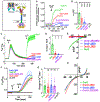Orai channel C-terminal peptides are key modulators of STIM-Orai coupling and calcium signal generation
- PMID: 34192542
- PMCID: PMC8462482
- DOI: 10.1016/j.celrep.2021.109322
Orai channel C-terminal peptides are key modulators of STIM-Orai coupling and calcium signal generation
Abstract
Junctional coupling between endoplasmic reticulum (ER) Ca2+-sensor STIM proteins and plasma membrane (PM) Orai channels mediates Ca2+ signals in most cells. We reveal that PM-tethered, fluorescently tagged C-terminal M4x (fourth transmembrane helix contains a cytoplasmic C-terminal extension) peptides from Orai channels undergo a Leu-specific signature of direct interaction with the STIM1 Orai-activating region (SOAR), exactly mimicking STIM1 binding to gate Orai channels. The 20-amino-acid Orai3-M4x peptide associates avidly with STIM1 within ER-PM junctions, functions to competitively block native Ca2+ signals, and mediates a key modification of STIM-Orai coupling induced by 2-aminoethoxydiphenyl borate. By blocking STIM-Orai coupling, the Orai3-M4x peptide reveals the critical role of Orai channels in driving Ca2+ oscillatory signals and transcriptional control through NFAT. The M4x peptides interact independently with SOAR dimers consistent with unimolecular coupling between Orai subunits and STIM1 dimers. We reveal the critical role of M4x helices in defining the coupling interface between STIM and Orai proteins to mediate store-operated Ca2+ signals.
Copyright © 2021 The Author(s). Published by Elsevier Inc. All rights reserved.
Conflict of interest statement
Declaration of interests The authors declare no competing interests.
Figures







Comment in
-
Commentary to Baraniak et al. "Orai channel C-terminal peptides are key modulators of STIM-Orai coupling and calcium signal generation" published in cell reports 35: 109322.Cell Calcium. 2021 Sep;98:102455. doi: 10.1016/j.ceca.2021.102455. Epub 2021 Aug 18. Cell Calcium. 2021. PMID: 34433107 No abstract available.
Similar articles
-
The STIM-Orai Pathway: Conformational Coupling Between STIM and Orai in the Activation of Store-Operated Ca2+ Entry.Adv Exp Med Biol. 2017;993:83-98. doi: 10.1007/978-3-319-57732-6_5. Adv Exp Med Biol. 2017. PMID: 28900910 Free PMC article. Review.
-
The STIM-Orai coupling interface and gating of the Orai1 channel.Cell Calcium. 2017 May;63:8-13. doi: 10.1016/j.ceca.2017.01.001. Epub 2017 Jan 8. Cell Calcium. 2017. PMID: 28087079 Free PMC article. Review.
-
Distinct gating mechanism of SOC channel involving STIM-Orai coupling and an intramolecular interaction of Orai in Caenorhabditis elegans.Proc Natl Acad Sci U S A. 2018 May 15;115(20):E4623-E4632. doi: 10.1073/pnas.1714986115. Epub 2018 Apr 30. Proc Natl Acad Sci U S A. 2018. PMID: 29712850 Free PMC article.
-
Pore properties of Orai1 calcium channel dimers and their activation by the STIM1 ER calcium sensor.J Biol Chem. 2018 Aug 17;293(33):12962-12974. doi: 10.1074/jbc.RA118.003424. Epub 2018 Jun 28. J Biol Chem. 2018. PMID: 29954946 Free PMC article.
-
Cross-linking of Orai1 channels by STIM proteins.Proc Natl Acad Sci U S A. 2018 Apr 10;115(15):E3398-E3407. doi: 10.1073/pnas.1720810115. Epub 2018 Mar 26. Proc Natl Acad Sci U S A. 2018. PMID: 29581306 Free PMC article.
Cited by
-
Dysregulated Ca2+ Homeostasis as a Central Theme in Neurodegeneration: Lessons from Alzheimer's Disease and Wolfram Syndrome.Cells. 2022 Jun 18;11(12):1963. doi: 10.3390/cells11121963. Cells. 2022. PMID: 35741091 Free PMC article. Review.
-
Neuronal Store-Operated Calcium Channels.Mol Neurobiol. 2023 Aug;60(8):4517-4546. doi: 10.1007/s12035-023-03352-5. Epub 2023 Apr 28. Mol Neurobiol. 2023. PMID: 37118324 Review.
-
STIM Proteins: An Ever-Expanding Family.Int J Mol Sci. 2020 Dec 31;22(1):378. doi: 10.3390/ijms22010378. Int J Mol Sci. 2020. PMID: 33396497 Free PMC article. Review.
-
Similarities and Differences between the Orai1 Variants: Orai1α and Orai1β.Int J Mol Sci. 2022 Nov 23;23(23):14568. doi: 10.3390/ijms232314568. Int J Mol Sci. 2022. PMID: 36498894 Free PMC article. Review.
-
CRAC and SK Channels: Their Molecular Mechanisms Associated with Cancer Cell Development.Cancers (Basel). 2022 Dec 23;15(1):101. doi: 10.3390/cancers15010101. Cancers (Basel). 2022. PMID: 36612099 Free PMC article. Review.
References
Publication types
MeSH terms
Substances
Grants and funding
LinkOut - more resources
Full Text Sources
Miscellaneous

